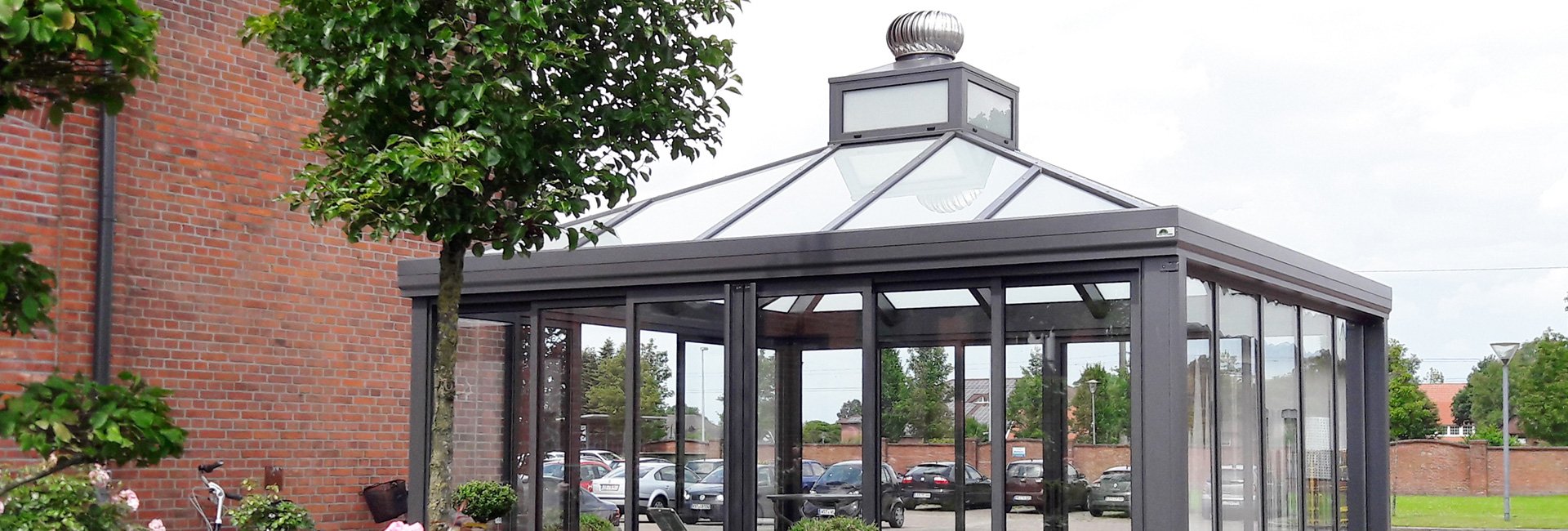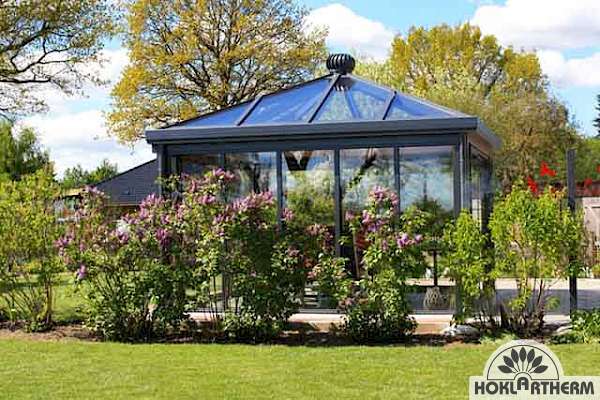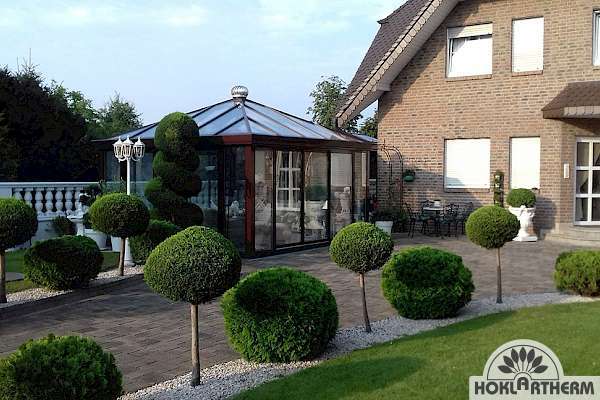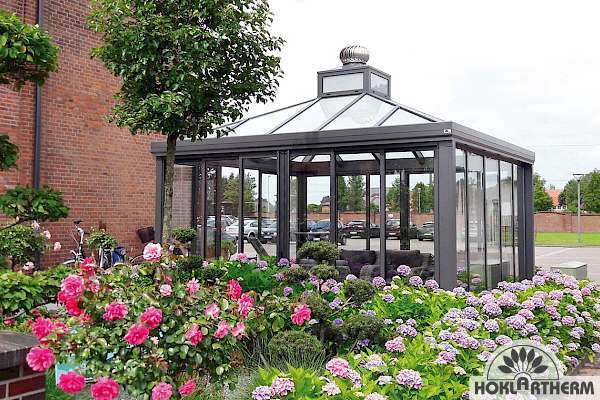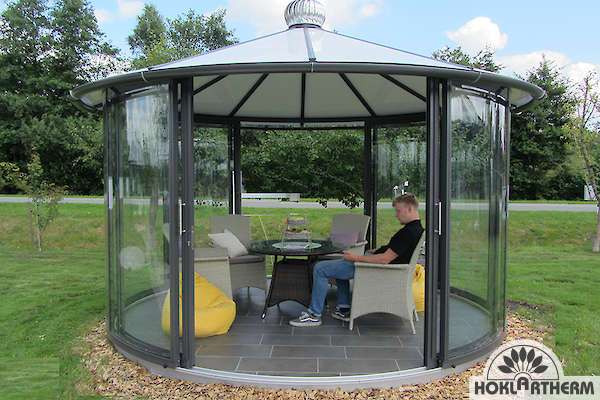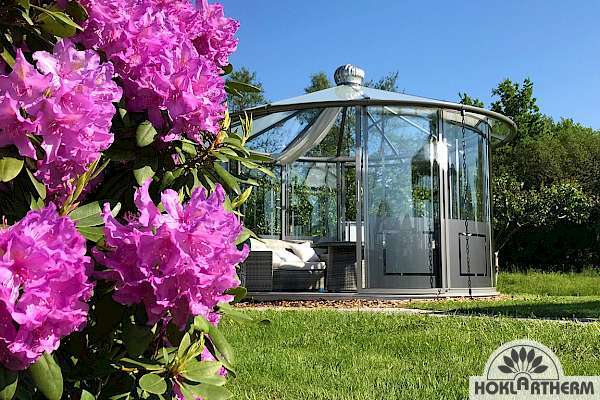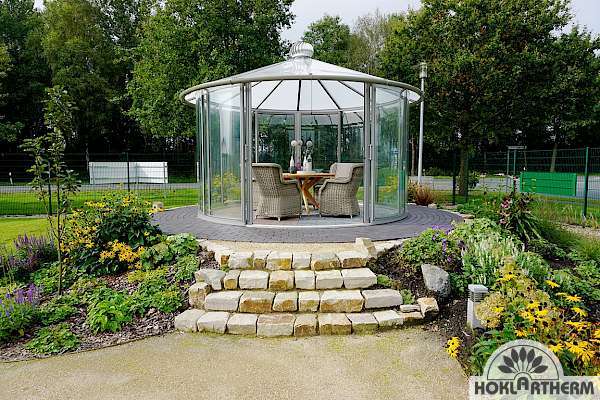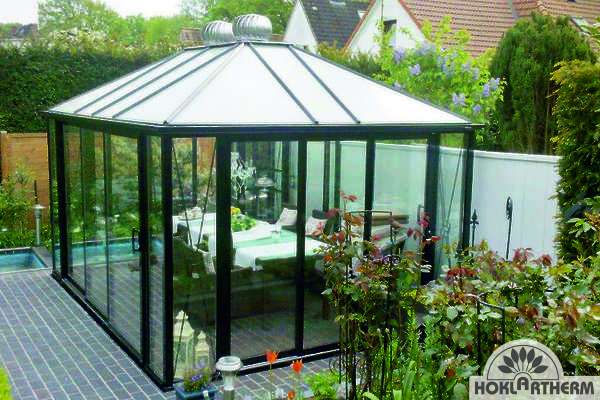Teahouse - Modern, Japanese style from Hoklartherm
The tea house originates from an old tradition in Asia, with curved pagoda roofs or dome roofs, often built with wood in the past. Modern tea houses are still sometimes built with curved roofs and wood, but here too, the development is moving towards modernity.
Read more
Nowadays, teahouses are available in rectangular shape, with sliding doors all around and roof ventilation. The materials used for construction are aluminum and glass. The standard for a tea house is 4m x 4m, but variations in and shape are possible. Please request a custom quote based on your specific wishes and preferences.
The Dream Teahouse by Hoklartherm
When looking for the perfect shelter for garden and patio seating areas, the possibilities are endless. Especially in garden pavilions, you can enjoy your garden almost year-round regardless of the weather, which is one of the reasons why they are so popular. Another reason is that today's models stylishly enhance the garden landscape, making them not only a retreat but also a focal point. It doesn't matter if you prefer the classic style, like modern design, or want to add nostalgic accents. The latter can be achieved particularly well with a teahouse for the garden. However, the name does not do justice to what a tea house truly is, as it is much more than just a place to enjoy tea at 5 o'clock. But what does the term teahouse actually mean, and where does this style come from? And in which garden does a tea house as a pavilion fit best? For those in the midst of planning their future garden design, the following information serves as a basic guide. For more information, especially regarding individual design options, our employees will be happy to provide assistance in a personal conversation.
For which gardens is a tea house best suited?
In general, a teahouse for the garden blends harmoniously with any landscape design. A tea house doesn't need a huge garden to make an impact. There are small versions available, like the round Classico pavilion in a nostalgic style, which fits perfectly in small gardens with its diameter of 3.31m.
A teahouse stands out mainly due to its design, setting it apart from traditional garden pavilions. Traditionally made of wood, tea houses from earlier times were often elaborately decorated with intricate elements.
Even today, there are various design options for teahouses in the garden. We offer you the proven Hoklartherm quality, which combines glass and metal ideas in a durable and stylish manner, for our tea house constructions, just like with all our products. Our tea houses are made with stable, corrosion-resistant aluminum profiles, feature multiple sliding doors, and are fully glazed with ISO safety glass. Various colour options are available. In addition to established designs such as the "Teehaus" or "Classico" pavilions in a nostalgic style, individual custom constructions are also possible.
Very British: a teahouse for the English garden
A tea house for the English garden is not only perfect for a traditional British tea ceremony but also for general relaxation. With its glazed walls and numerous design possibilities, a tea house as a pavilion fits perfectly into the special charm of gardens designed in the English style. The glazed side walls allow you to enjoy the view of the structured natural beauty of these garden landscapes. English gardens are based on clear, architectural structures. Lawns, flower beds, and paths are laid out in geometric shapes, providing the basic design framework. Tea houses as retreats are typical for this style and harmonize perfectly with the English look.
Living culture: a Japanese teahouse for Asian gardens
The style of Japanese gardens, which represent an idealized landscape on a smaller scale, is gaining more and more followers even here. Japanese gardens exude a fascinating and meditative atmosphere. The of the garden doesn't matter for this style - a Japanese tea garden can be created on less than 400 square meters. Curved paths, often with uneven stones, and a deliberate selection of plants such as rhododendron, Japanese maple, or bamboo are essential design elements. When looking for a garden pavilion for such Asian-style gardens, a tea house is the natural choice. Typically, a Japanese tea house in the garden is often surrounded by a water basin. For beginners in garden design, working with experienced landscape gardeners is highly recommended.

The modern teahouse in the garden

Pavilion teahouse in a sea of flowers
Further applications for a tea house as a garden pavilion
A sturdy garden pavilion or a teahouse made of glass and metal is a long-term investment that is not only suitable as a retreat in a private garden but also offers a variety of uses - whether in a spa park, public garden facilities, or as a protected seating extension for restaurants and hotels. For example, a larger tea house can be used as an ideal venue for readings or as a stylish smoking pavilion in the hospitality industry.
If you decide to buy a teahouse, you will find competent contacts who will work with you to plan your individual tea house that perfectly matches the style of your garden. You then have the choice of whether to build the tea house in the garden yourself or have it assembled by our professional staff.
What is a tea house for the garden?
As a design element in landscape architecture, tea houses for the garden are particularly well-known in Japan, China, and England. They are built in gardens as retreats or traditionally in places with particularly beautiful views, or as cozy hideaways in romantic rose gardens. The original idea of the teahouse comes from Asia, where classical tea houses with curved pagoda or dome roofs adorn Japanese gardens. Depending on the design, a tea house can evoke nostalgia or romance in the garden or emit Asian flair as a Japanese tea house. While a tea house as a garden pavilion was traditionally made of wood, there are still versions with curved wooden roofs nowadays, but the trend is towards modern materials. There are now numerous modern variations of tea houses made of aluminum and glass with curved pagoda roofs or dome roofs, available in square, hexagonal, or round versions with sliding doors all around and roof ventilation. A rotating glass pavilion is also now possible.
KONTAKT
Ihr Ansprechpartner zum Thema Pavilions

Eugen Langlitz
+49 4489 - 9281 - 62
Sie erreichen mich Montag-Freitag von 7.00 bis 18.00 Uhr und Samstag von 9.00 bis 16.00 Uhr.
We will be happy to advise you:
As a passionate manufacturer, we have been producing garden ideas made of glass and metal in Apen for over 40 years. We want your garden to be your absolute favorite place where you feel at home at all times. That's why we are at your side from the initial consultation through to installation - for greenhouses, pavilions, conservatories and more.
